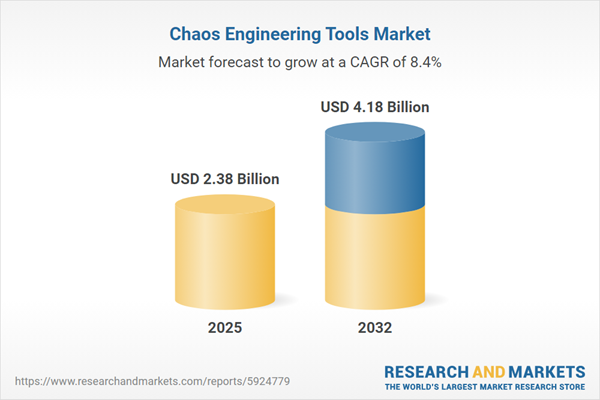Speak directly to the analyst to clarify any post sales queries you may have.
Enterprises navigating digital transformation and tightening regulations are turning to chaos engineering tools to build reliable, adaptive IT environments. Senior leaders recognize these solutions as strategic assets, supporting both operational resilience and informed risk management in an increasingly complex technology ecosystem.
Market Snapshot: Chaos Engineering Tools Market Trends and Growth
The chaos engineering tools market is experiencing robust expansion, currently valued at USD 2.20 billion in 2024. It is projected to grow to USD 2.38 billion by 2025, with an anticipated rise to USD 4.18 billion by 2032, translating to a compound annual growth rate of 8.36 percent. This growth is driven by increased adoption of chaos engineering across cloud-native architectures, DevOps workflows, and modernization initiatives. Sectors such as financial services, insurance, banking, and technology are intensifying their focus on IT resilience to advance digital transformation and meet evolving regulatory demands. Leadership teams are prioritizing IT reliability and risk reduction as essential components of competitive market positioning.
Scope & Segmentation of the Chaos Engineering Tools Market
The chaos engineering tools market addresses multiple organizational priorities by segmenting solutions based on deployment, application, scale, and industry needs. Segmentation supports leaders in aligning technology investments with specific resilience, compliance, and modernization goals.
- Deployment Mode: Options include cloud-based, hybrid, and on-premises solutions, enabling organizations to select models that best support business continuity, strategic growth, and infrastructure integration.
- Application Type: Solutions are suited for monolithic systems, microservices, and serverless environments, providing resilience coverage for both legacy and modern IT assets.
- Organization Size: Mid-size and large enterprises leverage tailored procurement strategies and specialized vendors to address distinct operational needs and regulatory requirements.
- Industry: Adoption is highest in sectors such as financial services, insurance, IT, telecom, e-commerce, and retail, where minimizing downtime and maintaining regulatory compliance are mission-critical.
- Offering Type: The market features commercial software, open-source frameworks, managed services, and consultancy options to help organizations address varied risk management and integration challenges.
- Regional Coverage: Market adoption varies by region, with the Americas, Europe, Middle East, Africa, and Asia-Pacific each influenced by unique regulatory, technological, and maturity factors.
- Key Companies: Providers include both established global leaders and specialized firms, delivering tailored solutions that address the complexity and compliance needs of regulated industries.
Key Takeaways for Senior Stakeholders
- Chaos engineering tools reinforce consistent IT service delivery, minimizing operational disruption during digital transformation efforts.
- Embedding resilience techniques in the CI/CD pipeline promotes early detection and resolution of system issues, fostering reliable innovation environments.
- AI and machine learning-driven automation of resilience simulations improves predictive capabilities and accelerates response times to emerging risks.
- Procurement planning benefits from incorporating compliance, scalability, and future-proofing considerations to support evolving operational demands.
- Coordination among DevOps, cybersecurity, and IT departments strengthens risk mitigation frameworks and ensures enterprise-wide adherence to resilience best practices.
- Modernizing infrastructure ensures sustained responsiveness to market shifts and helps organizations meet the expectations of demanding customers in rapidly changing sectors.
Tariff Impact and Strategic Procurement Adaptation
Ongoing tariff adjustments in the United States are prompting enterprises to favor cloud-native and subscription-based chaos engineering tools, decreasing their dependence on imported hardware. These choices offer adaptable IT budgeting and reflect shifts toward more flexible capital expenditure practices. Additionally, organizations are increasing adoption of open-source tools, simplifying integration and compliance with international standards. This approach enables companies to manage compliance uncertainties and increase architectural flexibility in their technology roadmaps.
Methodology & Data Sources
This report synthesizes findings from proprietary quantitative analysis, industry research, and direct interviews with DevOps and IT leaders. The methodology ensures senior executives receive impartial guidance for critical enterprise investment decisions.
Why This Chaos Engineering Tools Market Report Matters
- Empowers executives to compare chaos engineering technology options that directly enhance operational continuity and align with evolving business priorities.
- Supports the creation of strategies designed to strengthen resilience, fulfill regulatory requirements, and boost IT effectiveness in demanding sectors.
- Provides actionable market insights to inform vendor selection and facilitate adaptation to ongoing regulatory or technological changes.
Conclusion
This analysis offers a clear foundation for advancing operational resilience and maximizing technology value. Senior leaders can leverage these insights to navigate increasing digital and compliance demands with agility and confidence.
Additional Product Information:
- Purchase of this report includes 1 year online access with quarterly updates.
- This report can be updated on request. Please contact our Customer Experience team using the Ask a Question widget on our website.
Table of Contents
3. Executive Summary
4. Market Overview
7. Cumulative Impact of Artificial Intelligence 2025
Companies Mentioned
The companies profiled in this Chaos Engineering Tools market report include:- Gremlin, Inc.
- Amazon Web Services, Inc.
- Microsoft Corporation
- Google LLC
- Dynatrace, Inc.
- Harness, Inc.
- PingCAP, Inc.
- ChaosNative Technologies Private Limited
- VMware, Inc.
- International Business Machines Corporation
Table Information
| Report Attribute | Details |
|---|---|
| No. of Pages | 198 |
| Published | October 2025 |
| Forecast Period | 2025 - 2032 |
| Estimated Market Value ( USD | $ 2.38 Billion |
| Forecasted Market Value ( USD | $ 4.18 Billion |
| Compound Annual Growth Rate | 8.3% |
| Regions Covered | Global |
| No. of Companies Mentioned | 11 |









